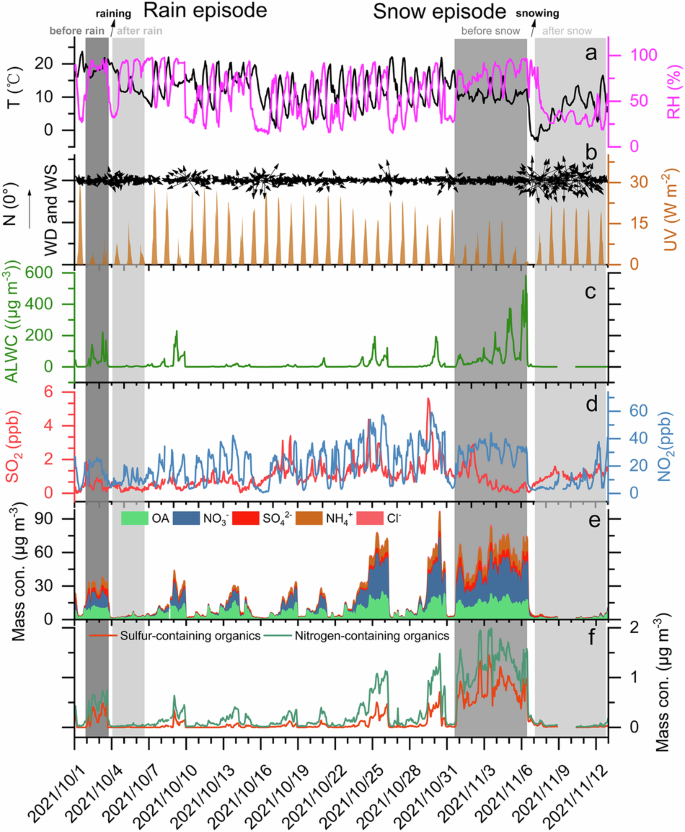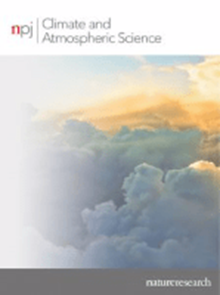北京城市含硫和含氮有机化合物的湿清除效应透视
IF 8.5
1区 地球科学
Q1 METEOROLOGY & ATMOSPHERIC SCIENCES
引用次数: 0
摘要
含硫有机化合物(SOCs)和含氮有机化合物(NOCs)在调节有机气溶胶(OA)的物理和化学性质方面发挥着至关重要的作用,但人们对它们的了解仍然有限。本文在北京城市地区对亚微米气溶胶进行了高分辨率实时测量,主要研究湿清除效应对 OA(尤其是 SOCs 和 NOCs)潜在形成和演化机制的影响。OA 成分从湿处理前的 SOCs 为主转变为湿处理后的 NOCs 为主。进一步的分子片段鉴定表明,在整个观测过程中,SOCs 主要包括水相处理形成的硫酸乙醇酸,以及降雪前光化学处理形成的芳香族和单萜衍生的 SOCs。NOCs 种类繁多,主要是光化学处理产生的高度氧化酰胺和氨基酸。这项研究深入揭示了城市大气中 OA 中 SOCs 和 NOCs 的潜在形成和演化途径。本文章由计算机程序翻译,如有差异,请以英文原文为准。


Insight into wet scavenging effects on sulfur and nitrogen containing organic compounds in urban Beijing
Sulfur-containing organic compounds (SOCs) and nitrogen-containing organic compounds (NOCs) play critical roles in regulating the physical and chemical properties of organic aerosols (OA), while the understanding of them remains limited. Here, the high-resolution real-time measurements of submicron aerosols were conducted in urban Beijing, mainly to investigate wet scavenging effects on the potential formation and evolution mechanism of OA, especially SOCs and NOCs. OA composition transitioned from being primarily SOCs before wet processes to NOCs after wet processes. Further molecular fragments identification suggested SOCs mainly comprised glycolic acid sulfate formed by aqueous-phase processing during the entire observation, and aromatic- and monoterpene-derived SOCs formed by photochemical processing before snowfall. NOCs species were diverse and dominated by highly oxidized amides and amino acids mainly produced by photochemical processing. This study provided an in-depth insight into the potential formation and evolution pathways of SOCs and NOCs in OA in the urban atmosphere.
求助全文
通过发布文献求助,成功后即可免费获取论文全文。
去求助
来源期刊

npj Climate and Atmospheric Science
Earth and Planetary Sciences-Atmospheric Science
CiteScore
8.80
自引率
3.30%
发文量
87
审稿时长
21 weeks
期刊介绍:
npj Climate and Atmospheric Science is an open-access journal encompassing the relevant physical, chemical, and biological aspects of atmospheric and climate science. The journal places particular emphasis on regional studies that unveil new insights into specific localities, including examinations of local atmospheric composition, such as aerosols.
The range of topics covered by the journal includes climate dynamics, climate variability, weather and climate prediction, climate change, ocean dynamics, weather extremes, air pollution, atmospheric chemistry (including aerosols), the hydrological cycle, and atmosphere–ocean and atmosphere–land interactions. The journal welcomes studies employing a diverse array of methods, including numerical and statistical modeling, the development and application of in situ observational techniques, remote sensing, and the development or evaluation of new reanalyses.
 求助内容:
求助内容: 应助结果提醒方式:
应助结果提醒方式:


